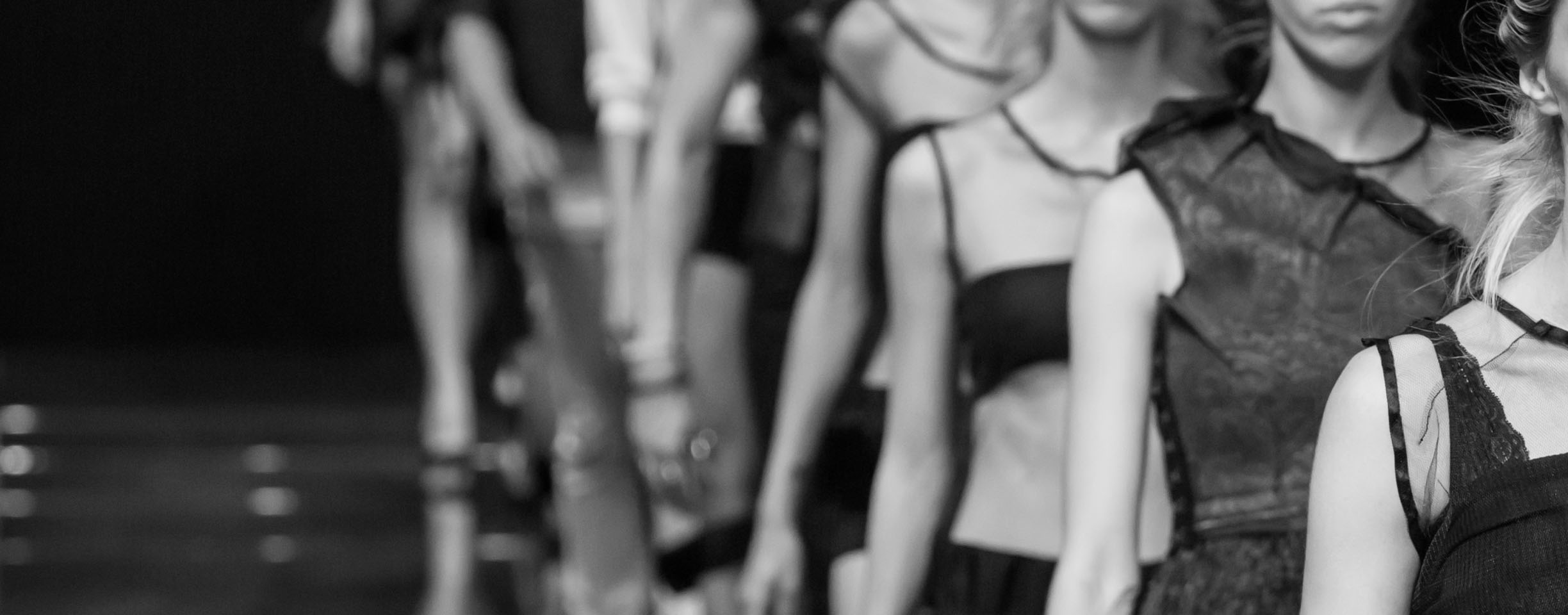
Fashion Week events run consecutively in four major capitals around the world called the “Big Four” – New York, London, Milan and Paris.
A fashion show is an artistic expression of a collection, which creates exposure and an emotional impact that entices audiences. Often exhibiting the creative brilliance and craftsmanship of a fashion designer and the inspiration that will translate to off-the-runway purchases.
Fashion shows, which originated in Paris in the 1800’s, were once private and intimate affairs for a select few. The collections were not released to the public until the collection was ready for purchase. It wasn’t until the 1940’s when press weeks became prevalent and fashion weeks became infinitely available. Paris, Milan, London and New York became the influencers and fashion capitals of the world each hosting large fashion weeks twice a year with thousands in attendance.
Since then the form of fashion shows has transformed dramatically focusing more attention on the artistic approaches, experiences and evoking emotion and connection between viewers and the collections. They have become essential in attracting global industry contributors consisting of brands, creative artists, models, retail buyers, media, celebrities and industry influencers. Prestige and exposure for brands comes with the territory of fashion weeks and provides fashion houses with credibility and legitimacy, enabling new and upcoming designers to be recognized, which is paramount when building brand awareness in order to procure top editorial layouts, attracting savvy retail buyers and loyal clients.
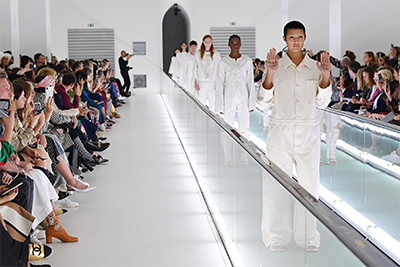
Photo Credit: Gucci - Runway - Milan Fashion Week Spring/Summer 2020, Jacopo M. Raule, Getty Images.
In recent years in the wake of Instagram and other social media platforms, another shift has taken place, where some fashion shows have turned into mass marketing spectacles and commercialization for millions of viewers, where the priority shifted from telling the story of the collection to how many engagements a brand would receive.
Fashion shows were never meant to be a commodity and disposable, but to make a lasting impression on audiences who not only engaged on social platforms but were inspired by the story behind the collection.
Fashion weeks have been in a massive transition phases, since it became apparent early this year that travel restrictions and social distancing concerns would prevent upcoming fashion weeks from proceeding as planned. Some of the most creative minds in the industry turned their attention to moving the events online through streaming video and digital runway shows. Highly-placed members of the fashion and technology industries, as well as analysts and press commentators, have put forth a variety of conflicting scenarios on the future turn of events affecting fashion weeks across the globe:
While the audience is packed with thousands in attendance, brands have millions of viewers at their fingertips watching live through digital platforms, aspiring to have a physical presence at a show. In current times brands quantify their return on investment by the number of eyes captured in hopes of leading to sales. The fashion show is a performance that a designer orchestrates, which elicits emotion, desire, inspiration and connection, creating a heightened sensory experience that can take a garment and turn it into a piece de resistance through sound, lighting, staging, choreography, styling and imagery. However, in order to increase the level of engagement with new and existing audiences, it is imperative that the true essence of the collection and story behind it has been captured both physically and digitally, providing a sense of novelty and scarcity leaving audiences with a feeling of exclusivity and relevance.
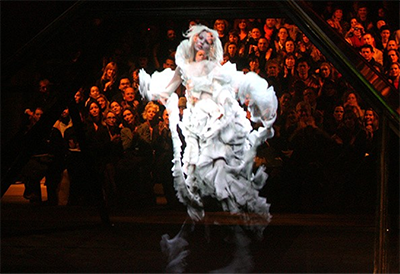
Photo Credit: Paris Fashion Week - Autumn/Winter 2006 - Ready to Wear - Alexander McQueen - Runway and Front Row, Andy Paradise, Getty Images.
Alexander McQueen was the creative genius who authenticated how physical and digital instantiations of fashion can complement each other in a physical space at his Autumn/Winter 2006 show, famously featuring a digital holographic illusion of Kate Moss in a flowing white gown materializing and dematerializing.
Similar ethereal virtual models have appeared in numerous fashion week events since then. 3D CGI representations of models and garments enable dramatic interactive virtual experiences for viewers and can be combined with live or recorded video; in July 2020 Burberry created a daydream-like campaign for a new collection by combining real-world imagery of Kendall Jenner with a CGI double wearing digital garments in a geometric computer-generated world. 3D digital representations are needed to enable the use of VR/AR technology or 3D displays like lightfield or holographic screens, which can immerse and engage the remote attendee more fully in a show, potentially even more than an in-person attendee sitting in a back row.
According to Robert Williams at BOF Dior, Burberry, Fendi and Chanel have made recent statements of “pivoting away from online-only events as quickly as possible, even if digital engagement with end consumers will remain a key component of their strategy.” (Robert Williams,“Why luxury brands aren’t giving up on a fashion month," BOF, 24, June 2020.) Luxury brands believe that despite the current market conditions and health restrictions, a physical fashion show embracing immersive experiences, is more influential when communicating their rich visions and craftmanship of their collections. Thus, resulting in capturing a larger percentage of the market with a higher MIV (Media Impact Value), while remaining true to their core as a luxury brands.
Because the transformation of fashion shows happened quickly, results were at best uneven. As Vogue Business reported, “Insiders say the digitisation of fashion week comes with the loss of emotion… getting it right is proving tough: London’s digital fashion week in June, spearheaded by the British Fashion Council, received mixed reviews and failed to draw significant attention online.” Launchmetrics estimates that the coverage for the London Fashion Week online-only event was 55% less in attendance than in the previous season prior to the COVID-19 outbreak in January 2020.
“ The digitization of Fashion Week will never
replace in-person events but it will largely enrich
and amplify creative expression and
communication,” Pascal Morand, Executive
President of the Fédération de la Haute Couture
et de la Mode
There has been a call for reopening physical fashion events as soon as practical, though the details of how an in-person fashion week might operate – and how attendees might feel comfortable given the current circumstances – remain open questions. As Christina Binkley, Editor-at-Large of Vogue Business, recently wrote, “The regimented human mashup that is a traditional fashion show — elbow-to-elbow guests from around the world, nose-to-nape models in line-up, back-to-back hair and makeup stations — have no place among sensibilities defined by Covid-19.” (Christina Binkley, “The fashion show, as we know it, is over,” Vogue Business, 17 May 2020).
Additional forces, both externally and internally, have been predicted to cause irreversible changes to fashion weeks, which some believe won’t fully revert to their pre-COVID-19 state. Even before the pandemic fashion weeks had been coming under fire relating to sustainability. The Carbon Trust has calculated that travel to such events emits 421,000 tonnes of CO2 annually, while in a pre-pandemic survey, 61% of fashion week participants reported feeling guilt over the environmental costs of fashion weeks. (Dhani Mau, “Fashion week is wasteful, exhausting and disorganized — but not altogether pointless, according to our survey,” fashionista.com, 6 Feb. 2020).
Alexandre de Betak, founder of the fashion show production company Bureau Betak, observes that remote participation will continue indefinitely post-pandemic: “We assume that from now on and forever, a part of the audience will not physically be there, due to sanitary, economic and ecological reasons.” (Laure Guilbault, “Predicting the Future of Paris Fashion Week, Vogue Business, 8 May 2020).
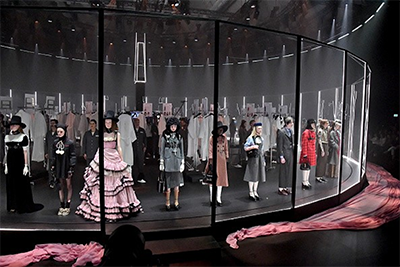
Photo Credit: Gucci - Runway - Milan Fashion Week Fall/Winter 2020/21, Victor Virgile, Getty Images.
Prior to the pandemic some brands were already addressing the negative impacts fashion shows have on the environment and have been taking action to reduce and offset their carbon emission footprints in various way. Burberry debuted their certified carbon neutral fashion show when presenting their Autumn/Winter 2020 collection. Alessandro Michele, the creative director for Gucci, announced that to stay true to their goals on climate change and sustainability, they would begin producing season-less collections that would go from 5 shows per year down to 2. He further added that the timelines imposed on them to create a collection are very stringent, and in order to not to have the creativity of the collection suffer, seasonless collections are more pragmatic.
“Rumours of its death are clearly exaggerated.
The coming weeks will see a wave of digital
simulacra, and there is hubbub about physical
get-togethers in September ... consider present
circumstances a state of suspended animation,
like a beauty that’s sleeping. I do know this: when
it wakes, it will be a very different creature.” Tim
Blanks, Editor-at-Large at BOF
Several organizations have arisen in recent years whose business models center on creating and selling digital-only luxury fashion merchandise for use in social media, digital platforms or multiplayer games. Some of the more outspoken representatives of this emerging segment have positioned digital-only fashion as the ultimate sustainability solution for luxury brands, arguing that they should pivot toward primarily selling garments that are made from pixels rather than fabric. Not surprisingly, the players in this digital-only garment business are also arguing that fashion weeks should similarly move to be digital-only events based on their CGI technology.
But the allure of luxury fashion merchandise is not strictly visual, and digital-only merchandise (or digital-only events) will never entirely capture the full sensory experience of the carefully selected materials and meticulous construction of luxury goods, or the subtle experiential aspects of the relationship of the wearer with the item, with the brand, and with the environment in which it’s showcased. For Modern Mirror, digital fashion is a vehicle to enhance the outreach and relevance of physical fashion, not a replacement.
So, were these expensive and experimental digital spectacles worth it for couture fashion week? Lauren Indvik reports that “the videos, for the most part, were dull or confusing, resembling film trailers or perfume adverts, and lacking narrative. The clothes themselves were difficult to see, obscured by studio lights, heavy splicing and poor video quality. Without the live element, there was none of that heady anticipation … Ultimately, the recordings did little to bolster brand equity – the real point of haute couture week.” (Lauren Indvik,“Nymphs, emojis and doll dresses: welcome to digital haute couture,” Financial Times, 9 July 2020.)
The true key to success is to transform a
one-of-a-kind experience into an everlasting
relationship with audiences.”
Nicole Reader, CEO
technology will never replace all offline retail and fashion shows, but will instead be used to transform the traditional runway show and create a more inspiring and inclusive event better connecting brands with their audiences. Through the integration of innovative technology, Modern Mirror explores the idea of fashion+tech as a contributor to nature and a humanity centred future.
Many of the digital fashion week events that took place this summer have been clever and creative examples of filmmaking but have not taken full advantage of the creative possibilities of what well-designed technology is capable of in terms of immersive experiences, interactivity and visual expression.
Much of the CGI rendering and digital character modeling technology needed for high-quality digital catwalk shows was developed in service of the gaming world, which has a visual style very different from what designers and brands are looking for. Modern Mirror, because of its deep experience in luxury fashion, is focusing development efforts on reworking the graphics technology and artistic practice to better match the sophistication, and the look and feel craftmanship of our luxury brand partners.
Modern Mirror challenges the traditional fashion production and operational processes by bringing sustainable solutions that are designed to assist in renewing the luxury experience that align with brands’ ideals and objectives, while staying true to the art of fashion and providing a positive environmental and social impact.
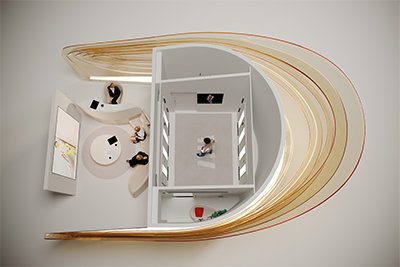
Photo Credit: Modern Mirror AFS Image Cabin
Solutions ranging from translating excitement off the runway to purchases – allowing consumers to be the models on their own runway. Thus, inspiring deeper engagement and inclusiveness between the brand and its clients, by providing confidence of how the collection will fit, wear and look like on them, prompting greater pre-sales leading to better inventory forecasting. To ensuring a true omni-presence both instore and online through the Avant-Garde Fitting System, enabling clients to virtually see how clothing looks, fits and moves on them anytime… anywhere…any device. While providing wholesale retail buyers with an interactive and customizable B2B virtual marketplace, where creative and artistic direction is endless.
We uncover analytics and intelligence, that provides brands the ability to have a solid grasp on their individual global consumers, and strategically amplify and individualize their brand experience. Making calculated decisions from design and stock to marketing and the customer journey, creating personalized experiences with highly emotional story telling that innate mystery and authenticity. We bridge the gaps, ensuring brands are ever-connected to their increasingly international market, with a firm footing on the global stage. Modern Mirror is not just for today’s consumers but for generations to come.
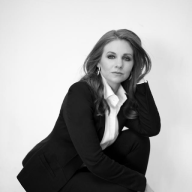
CEO & President
A CEO with a diverse background in the fashion industry ranging from modelling, design and pattern making, product launching, visual merchandising, runway shows, and styling. “Creating a one-of-a-kind experience that unlocks the next level to personalization of shopping with a lasting effect.”
CONTACT US TO BE a featured contributor
press@themodernmirror.com